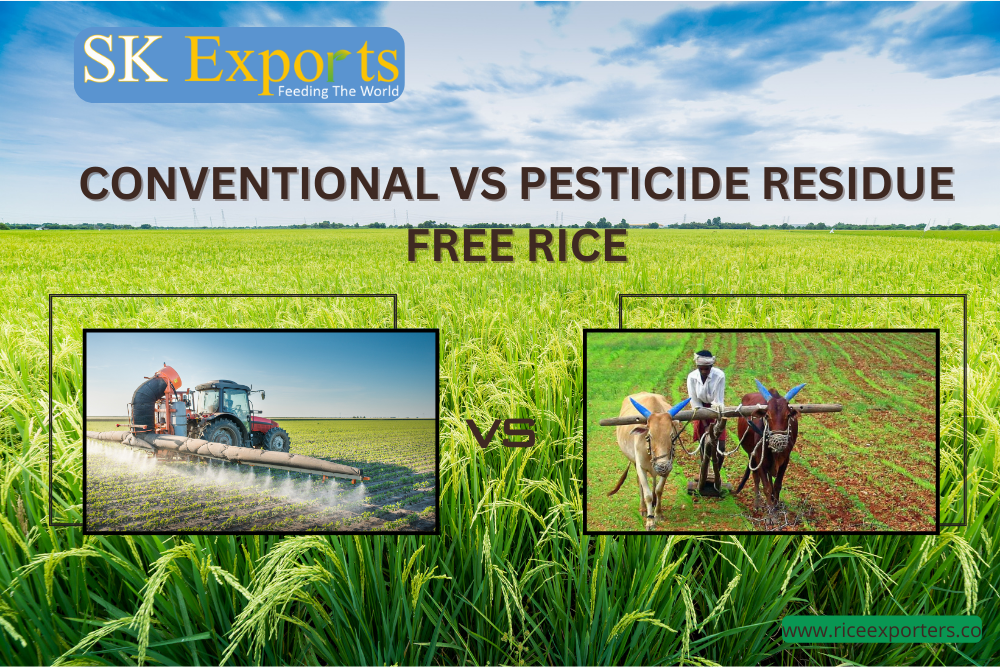Introduction:
Rice, a staple food for billions globally, plays a crucial role in providing essential nutrients and energy. However, the conventional methods of rice production, which often involve the use of synthetic pesticides, have raised concerns about potential health and environmental impacts. This has led to the emergence of pesticide-residue-free rice as a promising alternative. In this comprehensive exploration, we’ll delve into the nuances of conventional and pesticide residue-free rice, discussing their production methods, health implications, environmental considerations, and how consumers can make informed choices for their well-being.
1. Understanding Conventional Rice
-
Production Methods:
Conventional rice production relies on the extensive use of synthetic fertilizers, pesticides, and herbicides to maximize yields and minimize crop losses. These chemical inputs help control pests, weeds, and diseases, ensuring a consistent supply of rice for consumers worldwide.
-
Concerns about Pesticide Residues:
Despite its widespread popularity, conventional rice has been associated with concerns about pesticide residues. These residues can persist on rice grains even after harvesting and processing, potentially exposing consumers to harmful chemicals. Prolonged exposure to pesticide residues has been linked to various health issues, including neurodevelopmental disorders, hormone disruption, and certain types of cancer.
-
Environmental Impact:
The environmental impact of conventional rice production extends beyond pesticide residues. Synthetic pesticides and fertilizers can leach into soil and water sources, contaminating ecosystems and harming biodiversity. Additionally, the intensive use of chemical inputs contributes to soil degradation, erosion, and loss of fertility, undermining the long-term sustainability of agricultural systems.
2. Introducing Pesticide Residue-Free Rice
Definition and Certification:
Pesticide residue-free rice, also known as organic rice, is cultivated using organic farming practices that exclude synthetic pesticides, fertilizers, and genetically modified organisms (GMOs). To achieve certification as pesticide residue-free, rice growers must adhere to strict organic standards set by certification bodies, ensuring the integrity of the production process.
Benefits of Pesticide Residue-Free Rice:
-
-
Reduced Exposure to Harmful Chemicals:
Pesticide residue-free rice offers consumers a safer alternative by minimizing exposure to synthetic pesticides and other potentially harmful chemicals. This can have significant health benefits, particularly for vulnerable populations such as pregnant women, children, and individuals with compromised immune systems.
-
Environmental Sustainability:
Organic farming practices used in pesticide residue-free rice production promote soil health, biodiversity, and environmental sustainability. By avoiding synthetic pesticides and fertilizers, organic rice cultivation helps protect ecosystems, conserve water resources, and mitigate climate change.
-
Healthier Soil and Water:
The absence of synthetic pesticides and fertilizers in pesticide residue-free rice production contributes to healthier soil and water quality. Organic farming methods focus on building soil fertility through practices such as crop rotation, composting, and cover cropping, enhancing the resilience of agricultural ecosystems.
-
3. Making Informed Choices
-
Reading Labels:
When purchasing rice, consumers should look for labels indicating that the rice is certified organic or pesticide residue-free. These labels ensure that the rice has been produced according to organic standards and is free from synthetic pesticides and other harmful chemicals. Additionally, consumers can look for third-party certifications from reputable organic certification bodies, such as the USDA Organic seal or the EU Organic logo, to ensure product integrity.
-
Choosing Organic Brands:
Opting for brands that are committed to organic farming and sustainability can further support the transition to pesticide-residue-free rice. By choosing organic brands, consumers can incentivize growers to adopt organic practices and expand the availability of pesticide-residue-free rice in the market. Additionally, supporting local and small-scale producers who prioritize organic farming can help strengthen local food systems and communities.
-
Supporting Sustainable Practices:
By choosing pesticide residue-free rice, consumers can actively contribute to sustainable agriculture and environmental stewardship. Organic farming practices prioritize soil health, biodiversity, and ecosystem resilience, promoting long-term sustainability in agriculture. By supporting pesticide residue-free rice producers, consumers can help preserve natural resources, protect wildlife habitats, and mitigate the adverse effects of conventional agriculture on the environment.
4. Advantages and Disadvantages
| Aspect | Conventional Rice | Pesticide Residue-Free Rice |
|---|---|---|
| Advantages | – Generally more affordable | – Lower pesticide exposure for consumers |
| – Widely available | – Environmentally sustainable farming practices | |
| – Higher crop yields due to synthetic inputs | – Promotes soil and water health | |
| – Supports biodiversity | ||
| Disadvantages | – Potential pesticide residues may pose health risks | – Higher cost compared to conventional rice |
| – Environmental impact of synthetic pesticides | – Limited availability in some regions | |
| – Soil and water pollution |
5. Nutritional Comparison
| Nutrient | Conventional Rice (per 100g) | Pesticide Residue-Free Rice (per 100g) |
|---|---|---|
| Calories (kcal) | 130 | 130 |
| Carbohydrates (g) | 28.7 | 28.5 |
| Protein (g) | 2.4 | 2.3 |
| Fat (g) | 0.3 | 0.2 |
| Fiber (g) | 0.4 | 0.6 |
| Iron (mg) | 0.4 | 0.6 |
6. Environmental Considerations
In addition to health considerations, the environmental impact of rice production is a crucial factor to consider when making food choices. Conventional rice production relies heavily on synthetic inputs, which can have detrimental effects on soil, water, and biodiversity. In contrast, pesticide residue-free rice cultivation emphasizes organic farming practices that prioritize environmental sustainability and ecosystem health. By choosing pesticide-residue-free rice, consumers can support regenerative agriculture and contribute to the preservation of natural resources for future generations.
Conclusion:
In conclusion, the choice between conventional and pesticide residue-free rice extends beyond personal preferences to encompass broader health, environmental, and ethical considerations. While conventional rice may offer affordability and accessibility, pesticide residue-free rice provides a safer and more sustainable alternative. By making informed choices, reading labels, and supporting organic brands, consumers can play a pivotal role in promoting health, environmental stewardship, and social responsibility in the food system.
